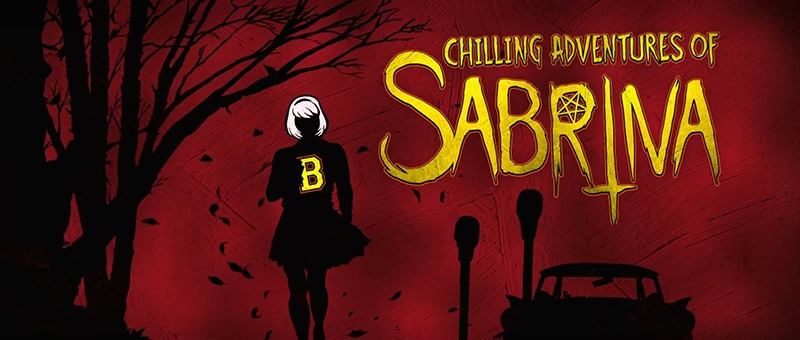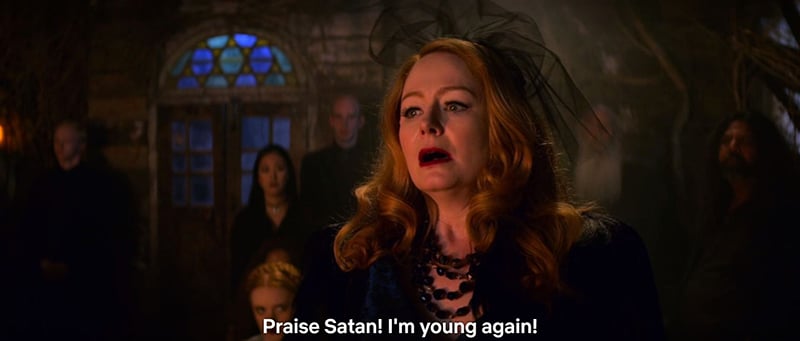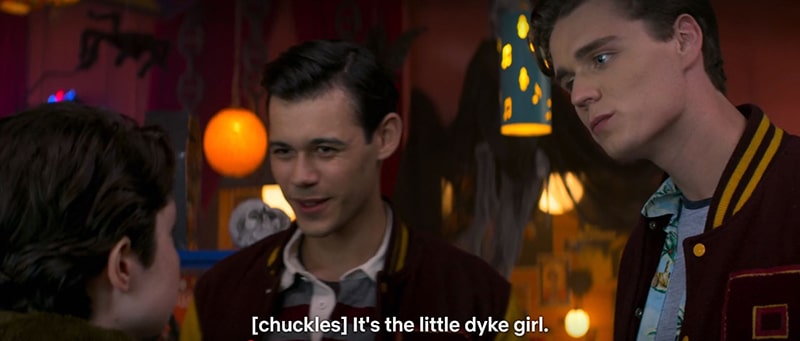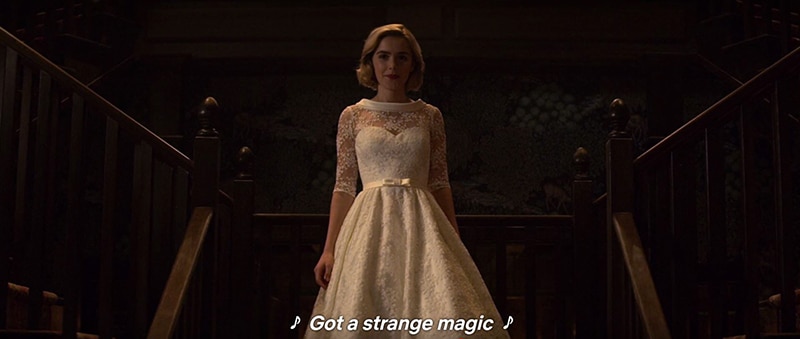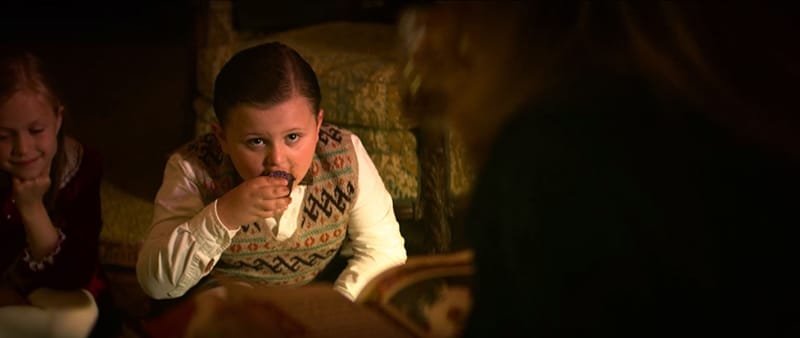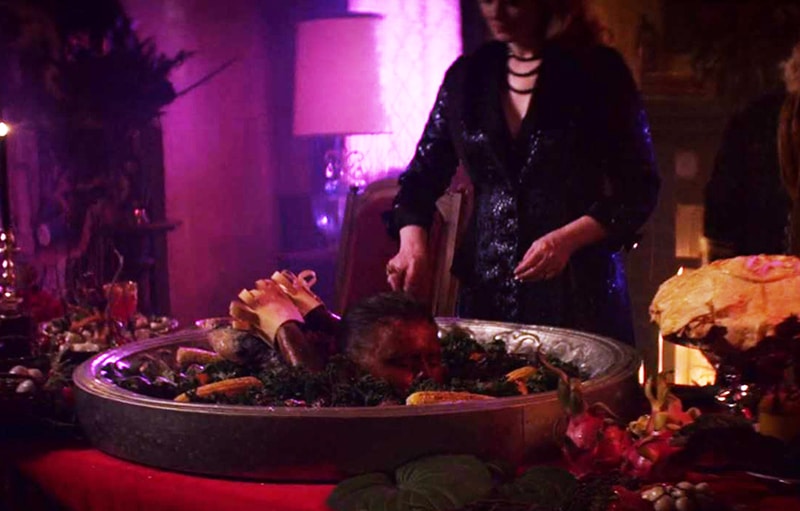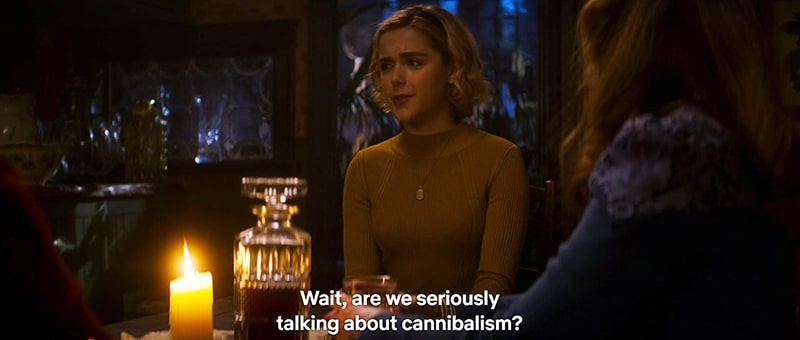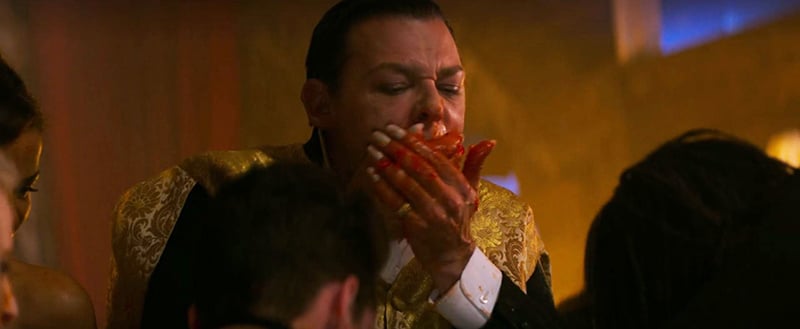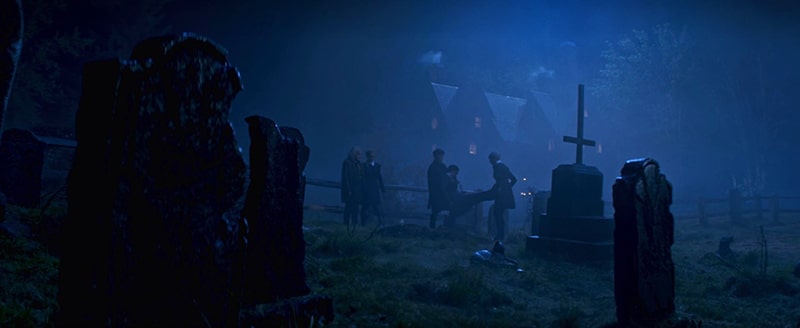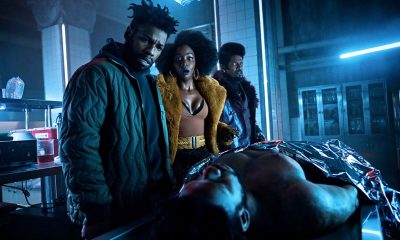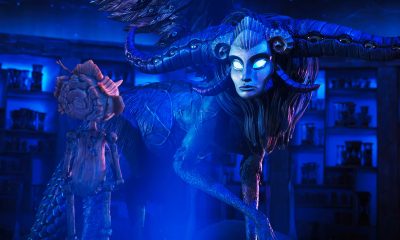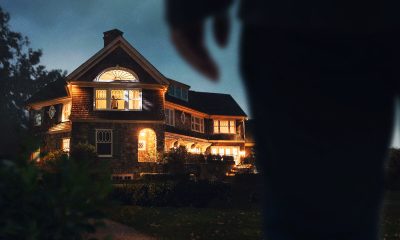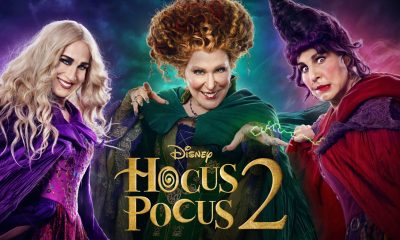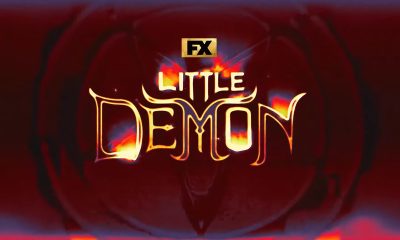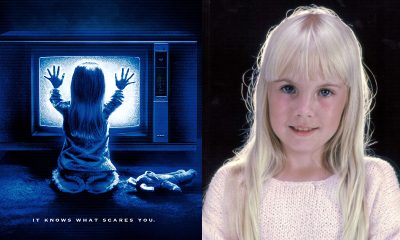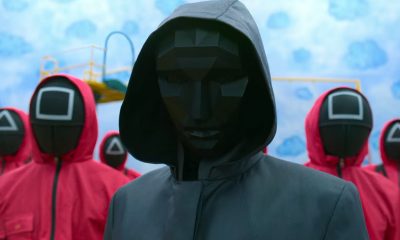Movies and TV
The Sick, Twisted Messages in “Chilling Adventures of Sabrina”
Aimed at teenagers, the series contains disturbing messages about Satanism, feminism, sexuality and everything in between. Here’s an in-depth look at the agenda behind Chilling Adventures of Sabrina.
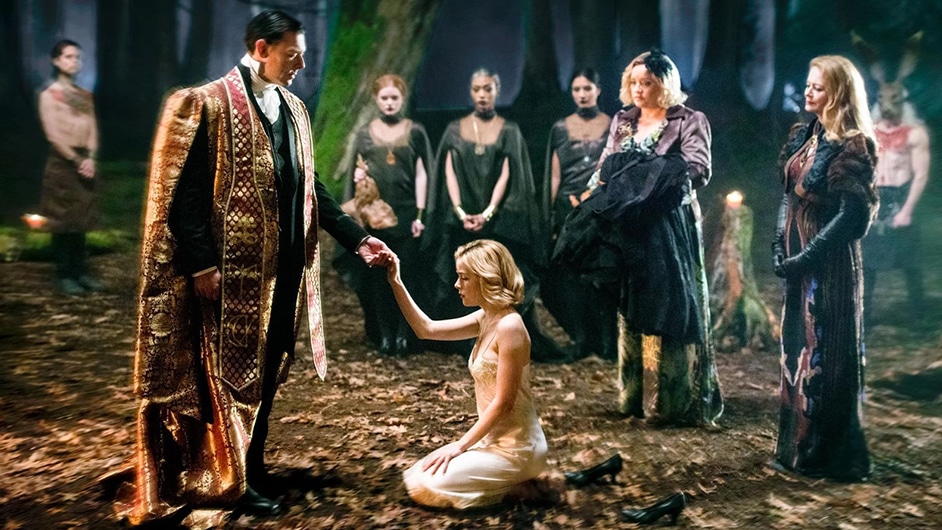
Warning: Major spoilers ahead!
With the advent of streaming services such as Netflix, entertainment is increasingly consumed in the form of multi-episode series. Spanning for dozens of hours, these series do not simply tell a story, they create immersive worlds in which viewers become greatly invested. Indeed, modern series are not strictly about a narrative – they’re long-winded experiences that become a part of the lives of those who watch, rewatch and binge-watch them.
The first season of Chilling Adventures of Sabrina, a series aimed at teenagers, contains ten one-hour episodes. In these ten hours of content, lots of words get said, lots of messages are implied, and lots symbolism gets burned in the minds of the viewers. And, as someone who sat through this first season (twice), I can confirm that there is a lot to unpack in there.
A few months ago, I wrote a short article titled “Chilling Adventures of Sabrina” Will Be Extremely Satanic, which described the overt satanic symbolism of the series’ trailer.
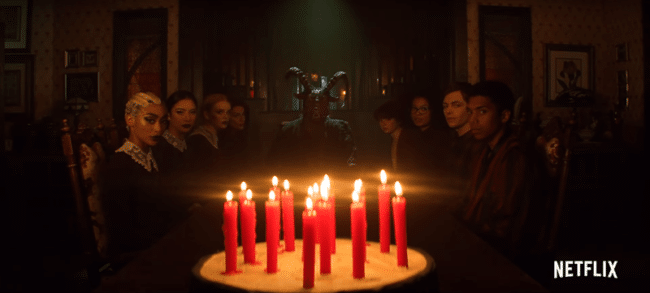
The trailer featured Sabrina celebrating her 16th birthday with Satan himself.
Released right before Halloween – the most important holiday in satanic circles – the series takes its young viewers into an occult adventure mixed with all kinds of social messages: The viewers are taught the basics of Satanism, that witchcraft is the best way to get back at the “patriarchy”, and that cannibalism is not that bad after all. In short, the series is the occult elite trying to brainwash children with its agenda.
The Premise
The series is based on the Archie Comic Sabrina the Teenage Witch. However, it was “re-imagined” to be darker and edgier … and to fit the elite’s agenda. The story takes place in the same universe as Riverdale – another series that is extremely popular with teenagers (and probably requires its own article). Both series were developed by Roberto Aguirre-Sacasa, a writer who is also known for creating Glee (pure musical horror) and for a play entitled Say You Love Satan, which is described as a “gay demonic romantic comedy”.
Chilling Adventures of Sabrina could also be described as a “demonic romantic comedy”, but it goes much further.
In the first episode, the premise is described as follows:
“In the town of Greendale, where it always feels like Halloween, there lived a girl who is half-witch, half-mortal, who, on her 16th birthday, would have to choose between two worlds: The witch world of her family and the human world of her friends”.
The main premise is custom-made to be relatable to teenagers. It is about a 16-year-old girl who goes to high school, loves her boyfriend, and goes out with her friends. But, also, she’s a witch and her family members are proud satanists. Throughout her infernal adventures, lots of disturbing things happen and lots of messages are delivered. Here are some of the themes exploited by the series.
Selling Satanism
In every episode of the series, the main “selling points” of Satanism are interwoven in the plot and presented in a way that is relatable to teenagers. Sabrina’s two aunts and cousin are staunch witches who yell out “praise Satan” whenever something good happens. However, they are not pointy-nosed harpies riding around on brooms, but likable, intelligent women who act as caring mothers to Sabrina. In fact, all witches in the series are witty, charismatic, good-looking people that are open-minded and tolerant of all lifestyles.
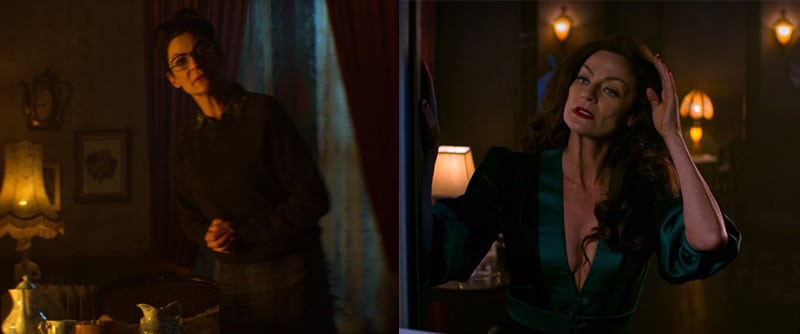
When she was a “good Christian” Ms. Wardwell was a boring and uptight little lady. After the “concubine of Satan” took over her body, she turned into a witty, sensual, and powerful witch.
As stated above, Sabrina has a dilemma: Should she become a super-powerful witch with all kinds of cool powers? Or should she remain a lame, basic girl? This is how the series presents the “dilemma”. As Sabrina says herself: “there are so many delicious things about being a witch”.
To become a witch, Sabrina must go through a “dark baptism” and give herself to Satan. However, Sabrina has some questions which are used to educate the viewers about Satanism. At one point Sabrina asks the High Priest of her coven:
” – But the Devil … he’s an embodiment of evil.
– Incorrect. He is the embodiment of free will. Good. Evil. Those words matter to the False God but the Dark Lord is beyond such precepts.”
Yes, throughout the series, God is referred to as the False God – an impotent and oppressive fatherly figure. To make the dark baptism even more appealing, the High Priest adds:
“In exchange for their service and devotion, witches are exempt from hell.”
Right before the baptism, the High Priest provides more Satanism 101:
“Our Dark Lord teaches us: There is no law beyond Do What Thou Wilt. Our Dark Lord asks: “Would you like to be happy, child? To be free? Free to love and hate? To be what nature meant you to be, true to her laws and yourself only?
– Yes father.
– Do you believe in Lucifer, the archangel, who preferred the loss of Heaven to the loss of his pride?
– Yes father.”
Later in the series, the viewers are taught the Satanic interpretation of the Book of Genesis.
“Did Eve die when she at the fruit, children? No. Of course not. The False God lied to Eve because he desired to keep her naked and ignorant in his garden. But our lord Satan, inhabiting a snake, gave Eve knowledge and set her free.”
As we’ll see later, Satan is often described as a liberating and empowering figure for women.
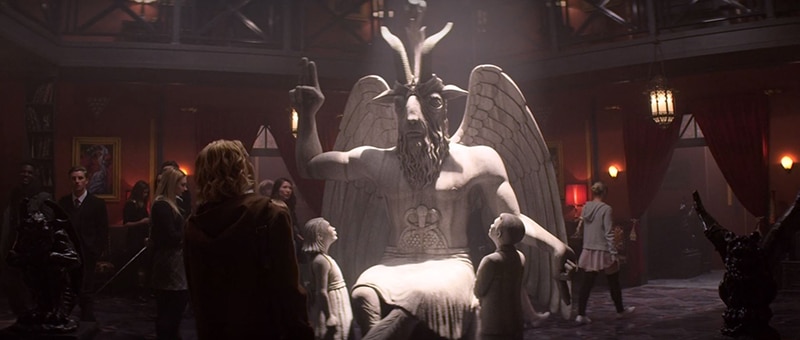
Inside the “School of Unseen Arts”, where witches learn invocations and demonology, a giant statue of Baphomet sits with “divine light” shining on it. It is an exact replica of the Baphomet statue installed by the Satanic Temple in Michigan.
The series is also full of small, twisted details. For instance, the Satanic choir of the school sings a song that begins with these words:
Always is always forever
As one is one is one
Inside yourself for your father
All is none all is none all is none
The name of the song is I’ll Never Say Never to Always and it was written by … Charles Manson. Yes, the crazy cult leader, serial killer and MKULTRA slave/handler Charles Manson.
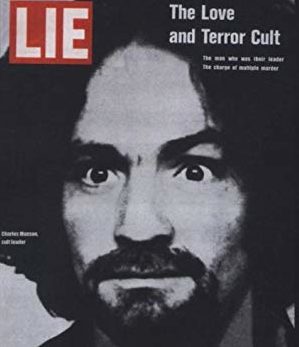
The song is from Charles Manson’s 1970 album “Lie: The Love and Terror Cult”. The occult elite loves Charles Manson.
As Sabrina learns about the dark arts, she sometimes rebels against her Satanic upbringing and tries to break from it. Does she succeed? Of course not. In fact, Sabrina ends up signing the Book of the Beast (giving her soul to Satan), which turns her into a super-powerful witch. And these super-powers end up saving the entire town of Glendale. Thank you, Satan.
To make Satanism even more appealing, the series also equates it with feminism.
Satanism: An Ally of Feminism and LGBQ
Nearly all of the men depicted in the series are angry, pushy, violent, homophobic, and judgmental brutes.
One of the first scenes of the series shows the jocks hitting Sabrina’s friend Susie who might become a transsexual. To make things worse, the school principal, described as a misogynist, does not take action. Who will save these girls from “toxic masculinity”? Witches, of course (powered by Satan). The message is clear: “Since men are more physically powerful than women, witchcraft is the best way to get back at them”.
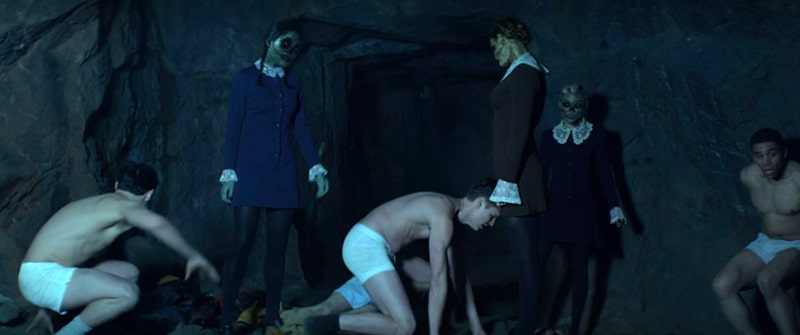
After using sex to lure the jocks into a cave, Sabrina and her witch friends use witchcraft to torment and humiliate them. The witches even cast a spell to make the boys impotent for an undetermined amount of time.
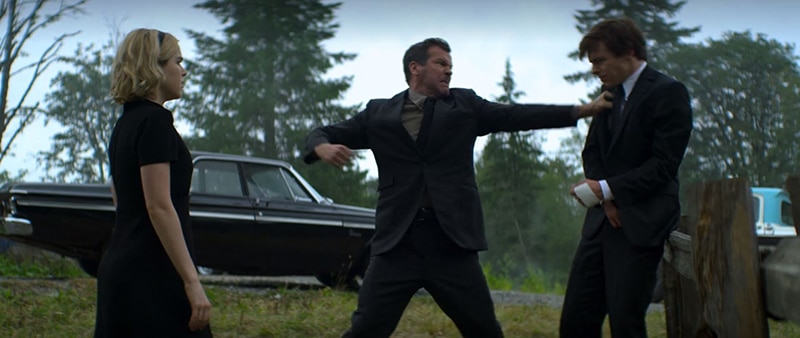
The father of Harvey (Sabrina’s boyfriend) is an angry violent jerk. In this scene, he’s about to punch his own son right in the face. Fortunately, a witch stops him from landing his punch with a spell. Again, thank you Satan.
Many other acts of witchcraft in the series are preceded with #metoo moments.
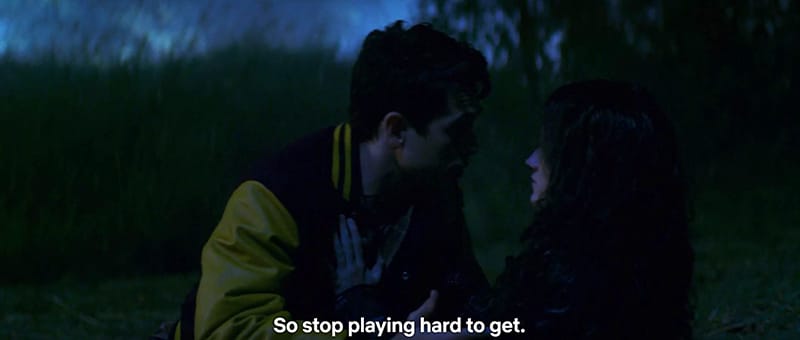
Ms. Wardwell needed to sacrifice a virgin to unleash a powerful spell. So she turns into a young girl and goes out with a jock who keeps forcing himself on her.
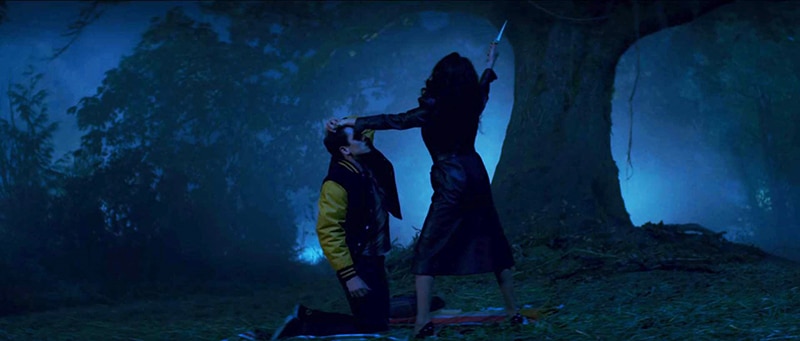
Ms. Wardwell then turns back to her older self and slashes the guy’s throat in a ritualistic matter. The message? He deserved to be sacrificed because he was being inappropriate.
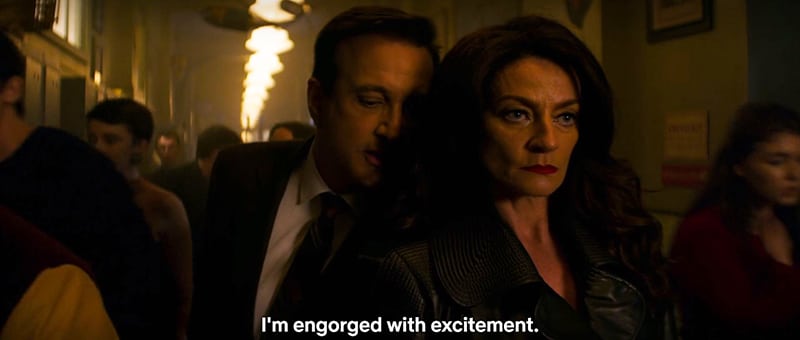
The principal of Sabrina’s school is a portrayed as an oppressive and misogynist figure. Also, he is constantly horny and keeps coming on to Ms. Wardwell in a swine-like matter. She ends up killing and eating him. Literally. As we’ll see later, the series is big on cannibalism. But he deserved it, right? RIGHT? To be eaten?
The final, crucial moment of the season—when Sabrina goes through with signing the Book of the Beast and hands her soul to Satan—is framed as feminist power-move. Ms. Wardwell tells Sabrina:
“I know you’re scared, Sabrina. Because women are taught to fear power. Own your power. Don’t accept it from the Dark Lord. Take it. Wield it. Save your friends”.
The relationship between witchcraft and feminism also involves her non-witch friends.
WICCA School Club
To protect Susie from bullies at school, Sabrina creates a club for “women protecting women” and to fight the “culture of puritanical masculinity”. The name of the club is WICCA which stands for “Women’s Intersectional Cultural and Creative Association”.
The word “intersectional” is not random. It refers to a very specific concept in “critical theories”.
Intersectionality is a concept often used in critical theories to describe the ways in which oppressive institutions (racism, sexism, homophobia, transphobia, ableism, xenophobia, classism, etc.) are interconnected and cannot be examined separately from one another. The concept first came from legal scholar Kimberlé Crenshaw in 1989 and is largely used in critical theories, especially Feminist theory, when discussing systematic oppression.
– Intersectionality, Definition
The acronym WICCA also has a meaning: It is a form modern pagan witchcraft. Once again, feminism and witchcraft are mixed together and presented as a cohesive whole to “empower” women. Sabrina even likens the school club to a witches’ coven where “sisters defend each other”.
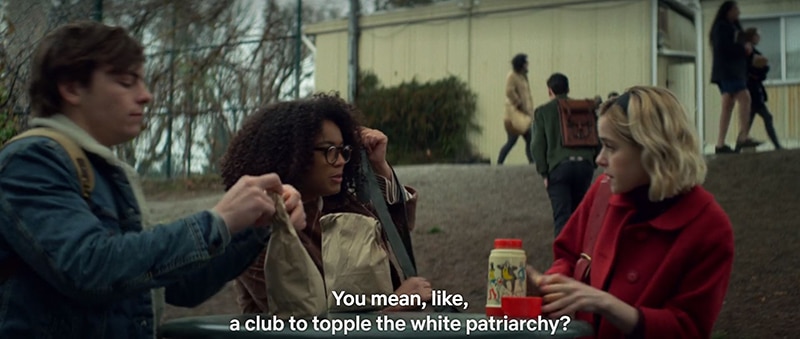
When Rosalind asks if the club is to “topple white patriarchy”, Sabrina answers “exactly”. The entire dialogue sounds contrived and unnatural to include as many social justice concepts and buzzwords as possible.
Once formed, WICCA members discover that some books were banned from the library by the school board. They make it their mission to get these books unbanned. Citing “fascism”, they claim that “no one should decide what we can and cannot read”. The books in question: The Bluest Eye and Lolita.
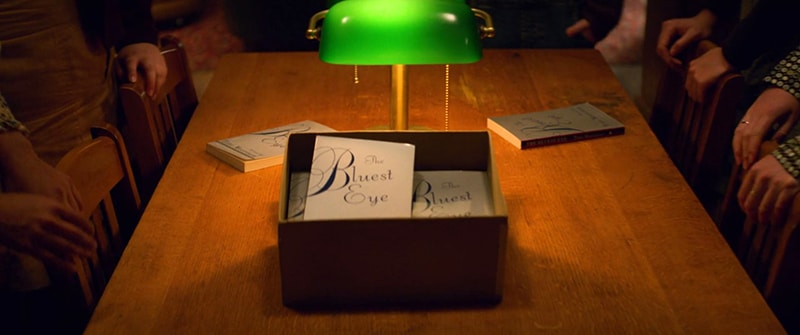
WICCA organizes a secret reading of the book “The Bluest Eye”. The club is supported by Ms. Wardwell who happens to be a demon.
Once again, the series refers to works and issues that are very real. The Bluest Eye is an actual 1970 novel written by the African American author Toni Morrison. Throughout the years, the book was banned by several school boards because it contains graphic scenes of “rape, abuse, incest, and child abuse”. One particular scene describes, in shocking detail, the abuse of a girl by her father and was deemed inappropriate to be read by children in several States. For instance, in 2016, a school in Michigan banned The Bluest Eye because it was deemed “pornographic” and contained “negative references against the Christian faith”.
WICCA also opposes the banning Lolita, a novel about a middle-aged man who becomes obsessed with a 12-year-old girl with whom he becomes sexually involved after he becomes her stepfather.
Why are they specifically fighting for and championing books involving adults with minors? Maybe because the entire series (and the occult elite that created it) is hell-bent on it.
Sexualizing Minors
At the moment of her dark baptism, Sabrina is still technically 15 years old. Despite this fact, the series clearly implies that her baptism involves her copulating with Satan.
White wedding dresses represent the purity of the bride and Sabrina’s virginity was deemed extremely important prior to the baptism. When she confirmed that she was still “untouched” prior to her dark baptism, her aunt replies: “Praise Satan!”. Sabrina then asks “Why does he get to decide what to do with my body?”. Lots of innuendo going on there.
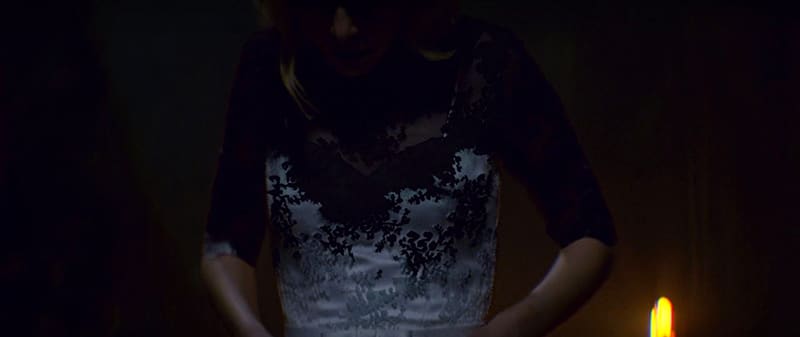
Upon entering the site of the dark baptism, Sabrina’s dress magically turns to black. Once again, the symbol of the white dress turning black appears in mass media.
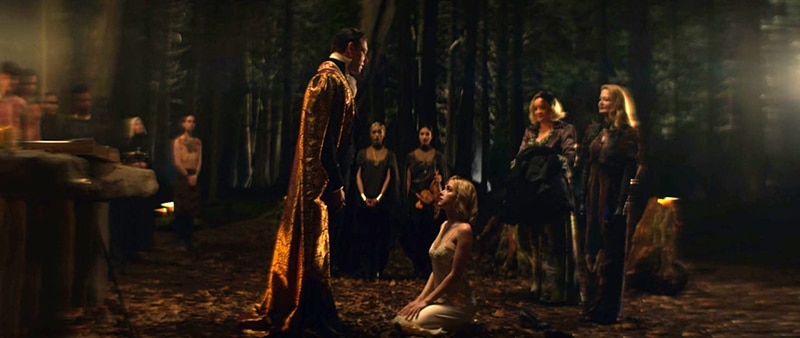
Then, Sabrina is disrobed by her aunts and kneels before the High Priest – Satan’s representative on earth.
Her signing the Book of the Beast is described as the “moment of consummation” between Satan and Sabrina. Like, when newlyweds go on their honeymoon. Then, things get even more blatant.
Once she enters the School of Unseen Arts, Sabrina discovers that her fellow students are into unbridled witch orgies where everything goes.
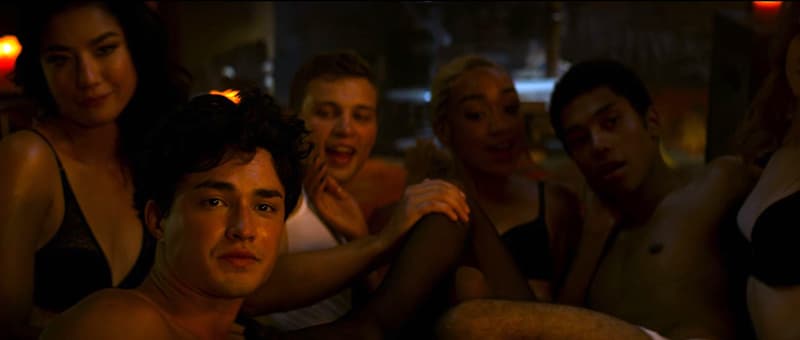
In this scene, Sabrina (who just turned 16) is invited to join a witch orgy, which also includes her pansexual cousin and his boyfriend.
The series also normalizes another obsession of the occult elite: Cannibalism.
Normalizing Cannibalism
In past articles on The Vigilant Citizen, I noted that cannibalism is, for some sick crazy reason, being promoted in mass media. Chilling Adventures of Sabrina is playing its part. Big time.
In the first episode, Sabrina’s aunts (who run a mortuary) receive the body of a boy who was stabbed to death. Upon looking at the cadaver, aunt Zelda sighs:
“It’s a shame they wanted an open casket—we haven’t had long pig in ages.”
The expression “long pig” is used by psychopaths to describe human flesh as food. Therefore, Zelda wanted to eat a young boy who recently was murdered. That’s great entertainment for our youth.
In a later episode, Zelda dreams about receiving Satan for dinner. She prepares him his favorite dish: Roasted child.
In the Thanksgiving episode, we learn that Sabrina’s coven celebrates a different holiday: “Feast of Feasts”. On this day, one “lucky” witch gets ritual sacrificed and is eaten by the rest of her coven.
Throughout the episode, Sabrina opposes this “barbaric practice” and attempts to stop it. And she succeeds: Sabrina’s friend doesn’t get eaten. However, on the night of the Feast of the Feasts, the witches become angry and demand blood. One particularly zealous witch then slits her throat and offers her body to the coven.
In the same episode, Ms. Wardwell says that she usually “orders in” on Thanksgiving.
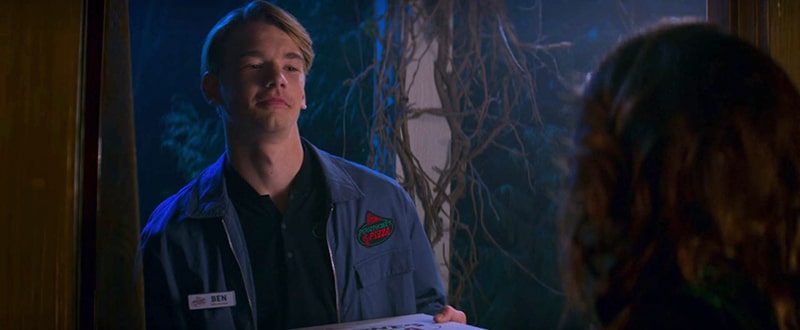
When the delivery boy arrives at Ms. Wardwell’s house, she asks him to place the pizza inside. Then she kills him and eats him. Well, he deserved it. He had a smug “I totally wanna bang that MILF” look on his face.
Desecration of Christianity
Satanic rituals and symbols are mostly based on the inversion, corruption, and perversion of Christianity. Chilling Adventures of Sabrina thoroughly desecrates Christianity in many ways – from subtle references to overt blasphemy.
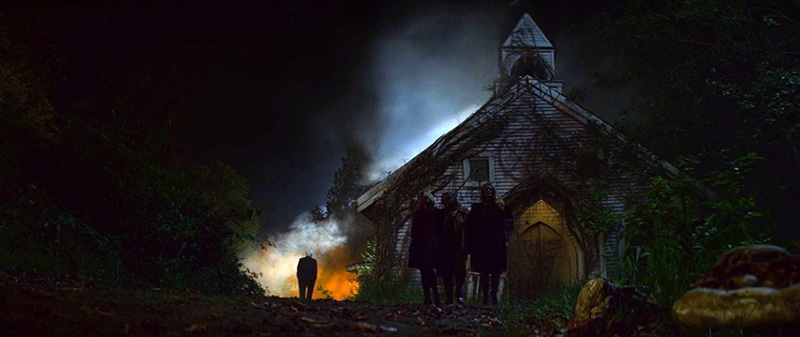
The rituals of the coven (including the Feast of Feasts) take place in a church on which were painted an inverted pentagram and the words “This way to hell”. Inside, the heads of the various religious figures were cut off.
In an early episode, when Sabrina asks questions about Satan to the High Priest, her aunt interjects and says:
“Forgive her Father, she knows not what she says”.
This sentence is a distortion of Jesus saying “Father, forgive them for they know not what they do” while crucified.
In another episode, aunt Zelda asks the High Priest for “spiritual guidance” and for a Satanic confession. Then, things get … not appropriate for children.
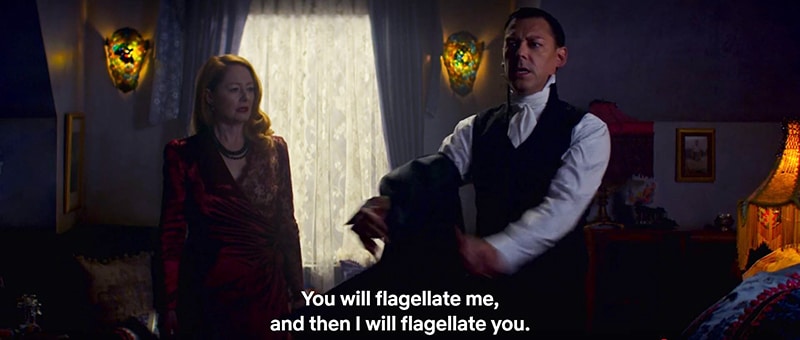
The confession turns into BDSM. The High Priest then adds: “Together we will suffer in exquisite ecstasy”.
Confession is a rite in the Catholic Church. The series turns it into a fetish. Also, Jesus was flagellated before bearing the cross.
Later, Sabrina tries to do Jesus-like things. When her boyfriend’s brother Tommy dies inside the mines, Sabrina decides that she should resurrect him – not unlike Jesus made Lazarus rise from the dead. However, Sabrina’s method involves the darkest of arts: Necromancy.
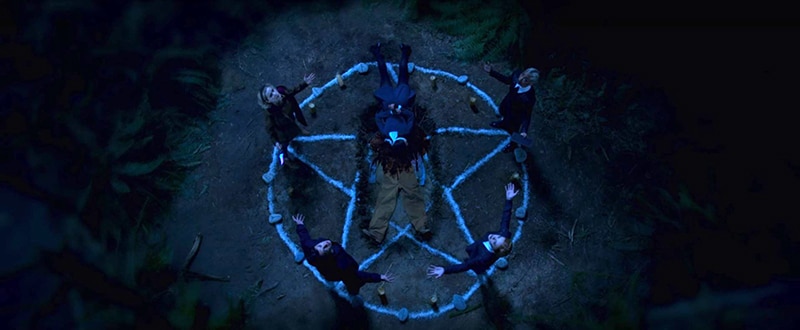
Sabrina performs a necromancy spell using the Book of the Dead, which also requires a blood sacrifice. So Sabrina slits the throat of a fellow witch.
After the ritual, Tommy is resurrected and goes back home. However, something is terribly wrong: Tommy came back as a soulless zombie who might kill his entire family. In the end, Sabrina’s boyfriend has to shoot his own brother in the head. In short, the entire ordeal was a corrupt version of Jesus’ resurrection.
Sabrina also wants to resurrect the witch that was sacrificed. To do so, she buries her in magical dirt called “Cain’s Pit”.
According to her aunt, the magical pit is made from “soil harvested from Cain’s garden and soaked with Abel’s blood”.
While this bit of dialogue might fly above the heads of most viewers, it bears a deep spiritual meaning. Here’s a quick recap of the story of Cain and Abel.
In the biblical Book of Genesis, Cain and Abel are the first two sons of Adam and Eve. Cain, the firstborn, was a farmer, and his brother Abel was a shepherd. The brothers made sacrifices to God, each of his own produce, but God favored Abel’s sacrifice instead of Cain’s. Cain then murdered Abel, whereupon God punished Cain to a life of wandering. Cain then dwelt in the land of Nod, where he built a city and fathered the line of descendants beginning with Enoch.
The Biblical story also adds that the “earth became cursed as soon as Abel’s blood hit the ground”. It is in this cursed dirt that Sabrina’s family resurrect dead witches. Occult circles perceive themselves as descendants of Cain who built a city and a lineage by his own means, without the assistance of God.
In Conclusion
Considering the grave and disturbing nature of the topics discussed above, it is hard to believe that this article was about a show aimed at teenagers (and probably also watched by lots of pre-teens and children). In many ways, Chilling Adventures of Sabrina is a typical teen series, custom-made to be relatable to them. However, on top of this basic teen-centric narrative, the series adds a thick layer of subversive messages meant to sell very specific ideas.
All of the topics discussed above (selling satanism, witchcraft as an ally of feminism and LGBTQ, sexualizing minors, glorifying cannibalism and desecrating Christianity) have been, for years, pushed by mass media in several ways. Chilling Adventures of Sabrina is yet another Netflix entry to is looking to shape and mold the youth to adopt specific ideas, values and attitudes.
In short, Chilling Adventures of Sabrina is a perfect snapshot of popular culture in 2018: Social propaganda mixed with overt Satanism.
- Paris Notre-Dame Cathedral's New Brand Identity
- Mockery Ensues
- Official seal of the University of Chile
- New footage shows debauched birthday party Diddy threw for Meek Mill
- The Economist / 2025 / The World Ahead
- Justin Trudeau claims fighting climate change is more important than feeding your kids
- Suspect at center of ISIS inspired Election Day terror plot previously worked for the CIA
Get an e-mail notification as soon as a new article is published on The Vigilant Citizen.
-

 Latest News2 months ago
Latest News2 months agoThe Controlled Demolition of Diddy
-
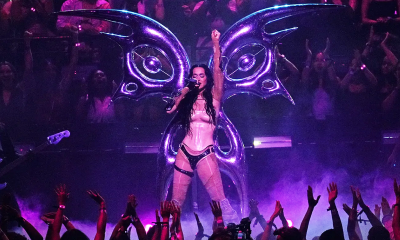
 Music Business2 months ago
Music Business2 months agoThe Hidden Meaning of Katy Perry’s Highly Symbolic Performance at the 2024 VMAs
-
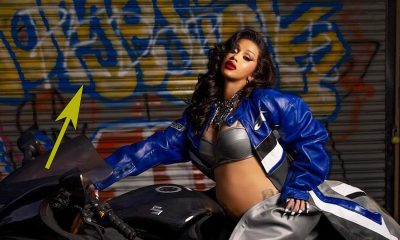
 Pics of the Month2 months ago
Pics of the Month2 months agoSymbolic Pics of the Month 09/24
-

 Movies and TV1 month ago
Movies and TV1 month agoAn In-Depth Look at the Hidden Meaning and Symbolism in “Blink Twice”
-

 Pics of the Month4 weeks ago
Pics of the Month4 weeks agoSymbolic Pics of the Month 10/24
-

 Music Business3 months ago
Music Business3 months agoSomething’s Terribly Wrong With Sabrina Carpenter and her Video “Taste”
-

 Latest News2 weeks ago
Latest News2 weeks agoKamala’s Campaign Was Objectively the Worst in Recent History
-

 Movies and TV2 months ago
Movies and TV2 months agoAn In-Depth Look at the Dark Messages and Symbolism in “Longlegs”
